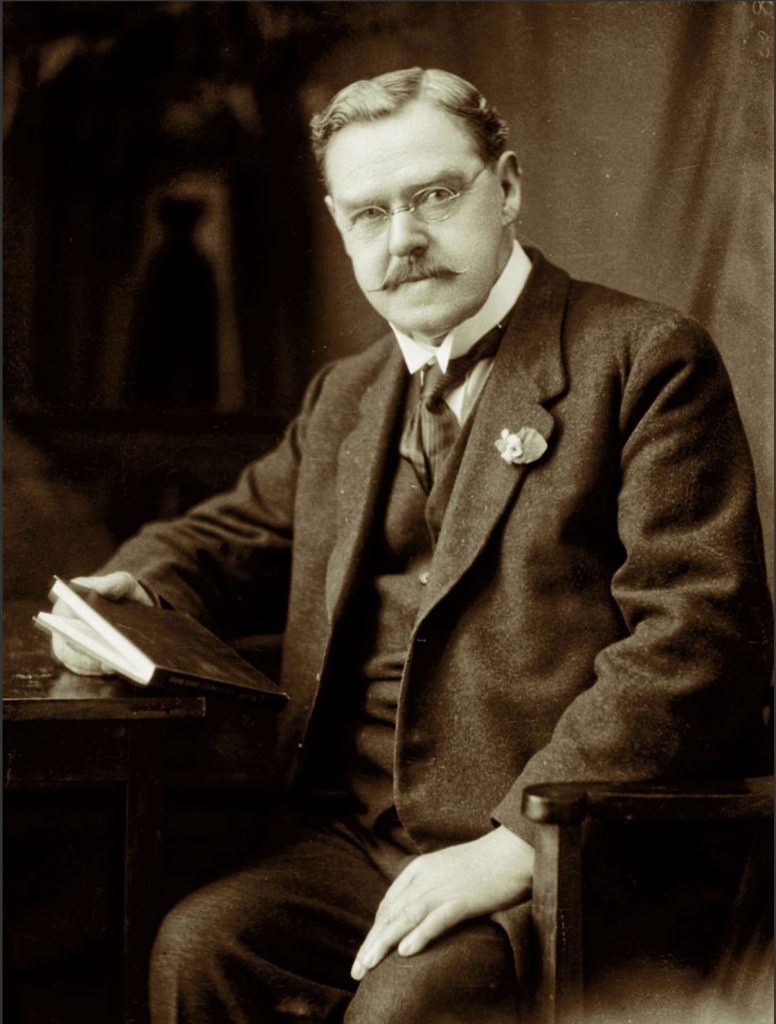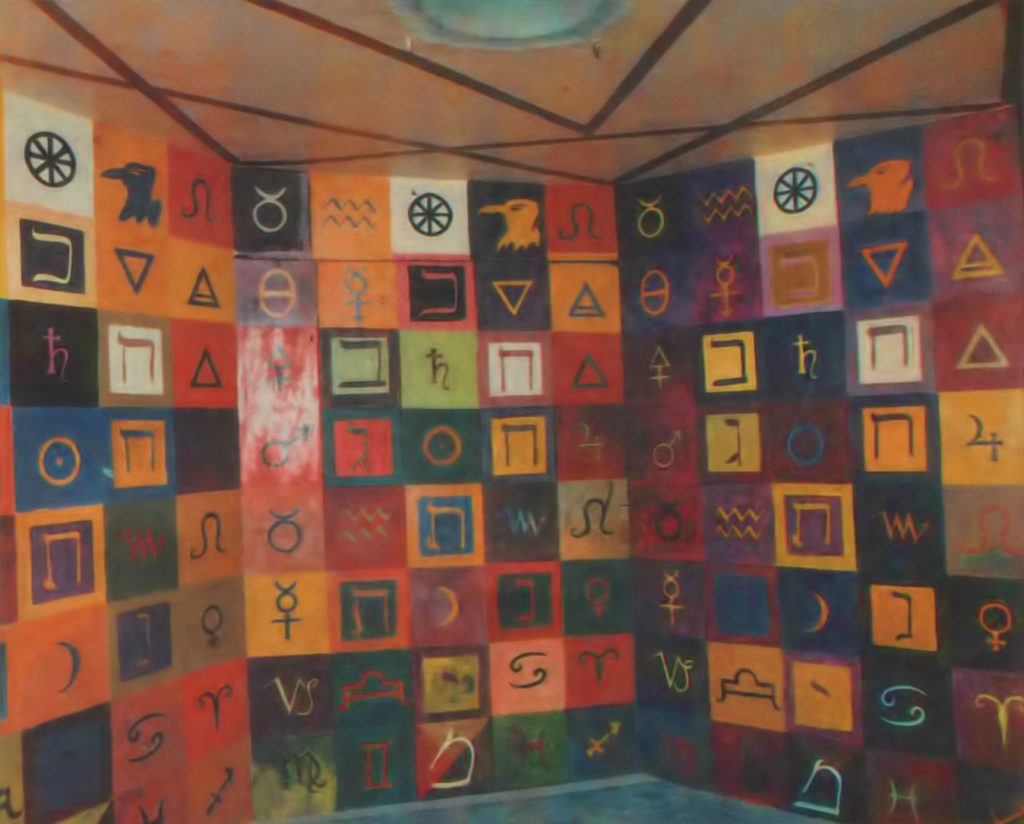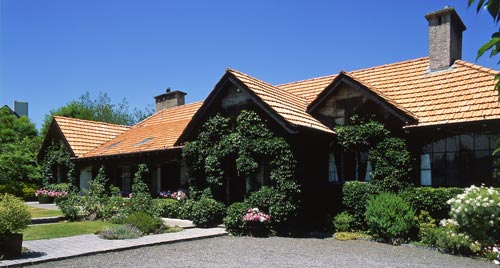Stories about an occult order secretly running a small town are the fodder of horror novels. Yet in early twentieth century New Zealand, the Order of the Golden Dawn thrived.
In his book Beyond the Sun, Author of the Month for July, Nick Farrell, investigates the strange story of Whare Ra, the last bastion of the Order of the Golden Dawn.
On the east coast of the North Island of New Zealand is the small village of Havelock North, which is nestled around TeMata Peak – a hill sacred to the Maori.
European settlement of the area was a disappointment. It was supposed to be a small city, but in 1874, when the Wellington-Napier rail line was built to run through the area, it by-passed Havelock North, which saw its population head to nearby Hastings.
In 1907, a Canadian immigrant to New Zealand, Reginald Gardiner, settled in Havelock North. Gardiner had money and so joined the newly formed New Zealand agricultural firm of Williams and Kettle. He also owned the local newspaper, The Hawkes Bay Tribune.
Havelock Work
Gardiner wanted Havelock North to develop what is now called a “community identity,” and remember its British culture. From 1908, he ploughed his spare time into a project called the “Havelock Work.” Initially, the Havelock Work was tiny and attended by only half a dozen to a dozen regulars and consisted mostly of readings from Shakespeare and Dickens in a church schoolroom. It developed into organising craft shows and re-enactments of Shakespearean pageants. While this would not attract much attention, the Havelock Work had a spiritual context with an emphasis on theosophy.
Eastern-influenced theosophy was not for Gardiner, but he felt that the church had lost the esoteric teachings of Jesus and his disciples. The feeling, which was standard at the time, was that Jesus’ secret teachings were to be found in Western esoteric occultism.
He formed an inner circle called the Society of the Southern Cross. It began to incorporate simple Christian rituals which were more like “moving prayers”.
In 1910, the Community of the Resurrection, an evangelical Anglican revival order better known as the Mirfield Fathers, sent a mission under the control of Father Fitzgerald to New Zealand, preaching and conducting retreats. At the time, the Mirfield Fathers were influenced by teaching that was considered “esoteric” and had links to different occult orders in England. Miss McLean, who had met Father Fitzgerald in Britain, arranged for him to meet members of the Havelock prayer group. Fitzgerald provided the group with the esoteric approach to Christianity it had been looking for and he recommended they contact Dr Robert Felkin.

Dr Felkin spent a lot of time in West Africa, and was known as a “medical medicine man” or expert in tropical medicine. It is unclear how Felkin became such an enthusiastic follower of ceremonial magic.
Felkin, the Magical Medicine Man
Felkin was Head of the British Order of the Stella Matutina which was the latest name of the more famous Order of the Golden Dawn. The Golden Dawn was and still is the reference for magical, occult orders. Founded by a London Coroner Wynn Westcott and the researcher Samuel Mathers, it attracted occult luminaries including the poet WB Yeats, Aleister Crowley, Dion Fortune, Israel Regardie and Arthur Waite.
Felkin was a Victorian hero—his adventures are written like something from a Victorian Boy’s Own magazine. He was a hard-bitten missionary who travelled through Egypt during wartime. He met the Victorian colonial war hero Gordon of Khartoum during the year-long siege of Khartoum by Muhammad Ahmad, before he was killed. Felkin narrowly avoided martyrdom of his own in West Africa thanks to his reputation, in his own words, as being a “medical medicine man” and an expert in tropical medicine. It is unclear how he became such an enthusiastic follower of ceremonial magic—some of his journals hint that he become convinced of its power in Africa.
When Felkin returned to England, he found himself as Head of the Order of the Golden Dawn after the group had split into two factions—a magical branch, which he ran, and a mystical Masonic section run by prolific writer and Christian mystic, Arthur Waite. Before receiving Fitzgerald’s request, Felkin had linked his order to the secretive continental Rosicrucians—the heirs to a magical and cultural movement that arose in Europe in the early seventeenth century—so he could have access to the higher magical grades.
Gardiner’s offer
Gardiner’s offer was a dream to an occultist of any era. It was to provide land, a purpose-built building for the Order to meet, and a regular supply of candidates from the local elite. It was an opportunity to use occult principles to shape a town’s destiny. Felkin jumped at the chance.
Felkin’s house, also a small doctor’s surgery, was designed by the legionary New Zealand architect James Walter Chapman Taylor (24 June 1878–25 October 1958). There was a secret temple in the basement, hidden by a bookshelf. Behind that were three hidden mini temples for the advanced grades.
Havelock North must have been aware that something odd was happening. Felkin made the mistake of trying to get the local builders to swear an oath to keep the creation of the building a secret, which was a little like telling the world. However, somehow, they collectively forgot about the strange building on top of TeMata Peak.
It is possible that they forgave Felkin for any strangeness after he single-handedly saved the town from the outbreak of Spanish Flu, which broke out a few years after his arrival. The local council recruited him to oversee its efforts to fight the flu and he was successful. No one in Havelock North died, while more than 73 died a few kilometres away, in nearby Hastings.
After the war, the Felkins were no longer interested in Europe and instead focused on providing serious training to candidates within the Golden Dawn system. The order was now called Smaragdum Thallasses or known by the name of Felkin’s magical house—Whare Ra or ‘The House of the Sun’ in Maori.
Secrets
Whare Ra was more than just an occult group. It was a secret society—most of its members were high members of the local community that controlled it. Not only did Whare Ra have control of the Havelock North Council, but it also had members on the Napier and Hasting councils. There were a few Members of Parliament, senior clergymen and a couple of governor-generals who could be called upon as loyal members.
One of New Zealand’s great military heroes, Andrew Hamilton Russell (23 February 1868–29 November 1960) was a Whare Ra member. Russell brilliantly led the New Zealand Mounted Rifles Brigade upon the outbreak of World War One and rose swiftly to high command during the Gallipoli Campaign. He commanded the ANZAC (Australian and New Zealand Army) evacuation from Gallipoli and went on to achieve further distinction as the commander of the New Zealand Division on the Western Front in 1917 and 1918.
Curiously, nothing in the New Zealand press was ever reported about Whare Ra. The fact that Gardiner owned the local paper might have had something to do with it. The rival newspaper, the Napier Daily Telegraph (which I worked for) should, however, have discovered it and run a story about Havelock’s secret society. Either Whare Ra was so mysterious that none of the local reporters discovered it existed, or their senior management, who owed Gardiner their jobs, managed to suppress it.
Security Leaks
There were “security leaks”—for example, a Whare Ra member’s wife who was a born-again Christian worried about the order’s influence. She arranged a meeting with the local Mayor and Town Clerk to attempt to get the order shut down. Little did she know that that the Mayor and Town Clerk were senior members of Whare Ra.
Women in the order had to wear red stockings, and many of them would troop through the village to the temple wearing them. Something like that is bound to get you noticed and turn you into a source of comment. Another potential leak was caused by the mother of the Whare Ra Chief. Betty Jones’ mother was a senior member of the order who suffered from dementia. She would stop strangers in the street and tell them things such as “There’s a holy ceremony tonight at Whare Ra, will you be attending?”.
In New Zealand, during the early days of the telephone, you had to call through telephone operators who knew of everything going on in town. They would often tell callers ringing those who were attending meetings things like, “There is no point in me putting you through, they are out of town.”
Unlike in a horror story, no one was murdered or even threatened during the Order of the Golden Dawn’s long history. Secrecy was maintained because Whare Ra was benign and portrayed itself as Christian. Most New Zealand towns had a Masonic lodge, with Masonic pubs and clubs. Pillars of the community who could not get into Masonic Lodges were often Rotary members. The fact that Whare Ra was Christian, and that its members attended church, meant that it was respected and not worried about, regardless of what it was up to.
It is difficult for many modern people to understand how this level of secrecy was maintained. One Whare Ra member told me that your best friends from the group would ignore you if you met in the street. This prevented people from having to ask difficult questions such as “how do you know him?”.
This attitude to secrecy remained among Whare Ra members long after the temple closed.
Christianity and summoning spirits
While an occult order taking over a town would usually be considered an omen, Whare Ra was inherently benign. Those working within the Order might have been summoning demons, but they would also pop round to each other’s houses to create spontaneous Christian prayer circles. They were incredibly focused on their community and on weaving the esoteric into everything they did. In the centre of the village there still is a roundabout where five roads meet—like the five points of a pentagram. The upper point (which Whare Ra attributed to “spirit”) points towards its temple.

The secret vault at the heart of the Whare Ra temple with each wall coloured to represent the seven planets. It was discovered hidden behind a secret wall by the new owners of the building after Whare Ra closed.
After Felkin
When Felkin died aged 76, there were 100 active members in the advanced grades of his temple and many more than that in the outer order. When you consider that Havelock North consisted of only 600 people when Felkin died, you start to realise the importance of Whare Ra to New Zealand’s and Hawke’s Bay’s religious and esoteric life.
Felkin’s wife and daughter took over the temple and influenced other New Zealand spiritual movements, including the Radiant Living movement, which influenced the conqueror of Mount Everest, Sir Edmond Hillary. When Mrs Felkin and her daughter died, the Order was taken over by the Mayor of Havelock North, John Von Dadelszen.
The death of the Order
By the early 1970s, Whare Ra was—in some ways literally—rotting from the inside. The building was badly in need of renovation. One of the Order’s chiefs, Betty Jones, had moved in to start the restoration work. Betty began to show symptoms of Alzheimer’s, which caused problems for the Order. Recruitment slowed down and teaching calcified.
In the mid-’70s, Von Dadelszen admitted that he lost the magical astral contact with the secret chiefs—the spirits behind the order. Since the days of Felkin, Whare Ra’s leaders had picked up psychic teaching and instructions from the same sets of inner plane beings. Suddenly, without explanation, they disappeared.
There were no further recruits, so this lack of interest from the wider world was seen as proof that the secret chiefs had abandoned Whare Ra.
By 1978, Von Dadelszen made the difficult decision to close Whare Ra, sell it, and to put the money into a New Age project in Taupo called the Tauhara project. The decision was made unilaterally and without any consultation from others within Whare Ra. According to the members I spoke to in producing my book, students were allowed to keep their material, but a bonfire was made for sixty years worth of Order papers. The bonfire lasted a whole weekend, and nothing was left. Von Dadelszen did not want to risk the member details of the “weird occult temple on the hill” being discovered.
Secrecy was maintained. In the 1990s, when I was a reporter working for the Napier Daily Telegraph, I wrote Von Dadelszen’s obituary. I spoke to the surviving Whare Ra members as part of the piece I was writing. No one ever mentioned Von Dadelszen’s links to Whare Ra, or esoteric beliefs. Indeed, it was only later that I found out about his esoteric past.
The temple was sold and later restored, more as a tribute to Chapman Taylor than to Whare Ra. Although Havelock North has quietly started to recognise its place in esoteric history, the story has come out mostly due to outsiders, and the town still does not precisely celebrate the time when it was run by an Occult Order. While New Zealand is and will always be a supporter of New Age groups, it is unlikely that they will ever have the financial and political power that was mustered by Whare Ra.
References
Benham, P. (2006). The Avalonians. Glastonbury: Gothic Image.
Budge, E. and Budge, E. (n.d.). The book of the dead.
Crowley, A., Symonds, J. and Grant, K. (1989). The Confessions of Aleister Crowley. London: Arkana.
Dunn, P. (1999). Robert Felkin MD (1853-1926) and Caesarean delivery in Central Africa (1879). Archives of Disease in Childhood – Fetal and Neonatal Edition, 80(3), pp.F250-F251.
Ellwood, R. (1993). Islands of the dawn. Honolulu: University of Hawaii Press.
Farrell, N. (2011). Mathers’ last secret revised – the rituals and teachings of the alpha et omega. [S.l.]: Rosicrucian Order Of The.
Farrell, N. (2012). King over the water. Dublin: Kerubim Press.
Farrell, N. (2014). The Hidden Path of Initiation. Rome: Lulu.
Howe, E. (1972). The magicians of the Golden Dawn. London: Routledge and K. Paul.
Inquire Within, (1930). Light bearers of darkness. London: Boswell Print. & Pub. Co.
King, F. (1970). Ritual magic in England. London: Spearman.
Mackey, A. and Clegg, R. (1921). Mackey’s symbolism of freemasonry. Chicago: The Masonic history Company.
Meihuizen, N. (1998). Yeats and the drama of sacred space. Amsterdam: Rodopi.
Nzhistory.net.nz, (2015). North Island Influenza Death Rates – The 1918 Influenza Pandemic | NZHistory, New Zealand History Online. [Accessed 26 Mar. 2015].
Regardie, I. (1971). The Golden Dawn. St. Paul: Llewellyn Publications.
Scott, E. (1890). Stanley and his heroic relief of Emin Pasha. Toronto: W. Bryce.
Sheringham, H. and Meakin, N. (1904). The court of Sacharissa. New York: Macmillan.
Sheringham, H. and Meakin, N. (1906). The enemy’s camp. London: Macmillan.
Stratton-Kent, J. (2010). Geosophia. [Dover]: Scarlet Imprint/Bibliothèque Rouge.
The Hermetic Tablet Vol. One Winter Solstice. (2015). Rome: The Hermetic Tablet.
Zalewski, P. and Lisiewski, J. (1988). The Secret Inner Order Rituals of the Golden Dawn. Phoenix, AZ: Falcon Press.
About the author
Nick Farrell is a journalist and translator working in Rome. He has been involved in esoteric groups since he was seventeen and worked with former members of Whare Ra, the last Golden Dawn temple to close its doors. He has written sixteen books on esoteric subjects and history. In 2009 he founded the Magical Order of the Aurora Aurea with his wife Paola. His latest book, Beyond the Sun: The History, Teachings and Rituals of the Last Golden Dawn Order, is about the history and teachings of Whare Ra, and was published by Skylight Press.














Thank you for your post, I look for such article along time, today I find it finally. this post gives me lots of advise it is very useful for me.
fireboy and watergirl
I drank a New Zealand wine called Te Whare Ra the other day, wonder if the wine is made at the same site?
Yeah, the vineyard is on Te Mata peak
Very good sharing about the author and the book. I love reading his works. High humanistic values.
fnaf
New Zealand is populated with British aristocrat descendants. The rules for drinking and partying are uptight. I would like to find out what Bruce Cathie, a deceased Kiwi would have to say about the location of Whare Ra in relation to his Earth Grid harmonics.
The green skinned pharaoh must be a reptilian. That’s a given. The crook and flail remind me of the rod and axe of the fasci. Tools to herd and discipline the ignorant mass of sheeple.
Is this true?